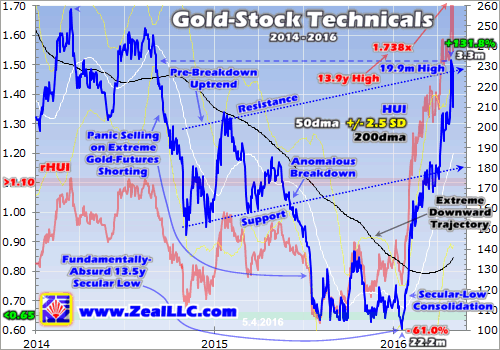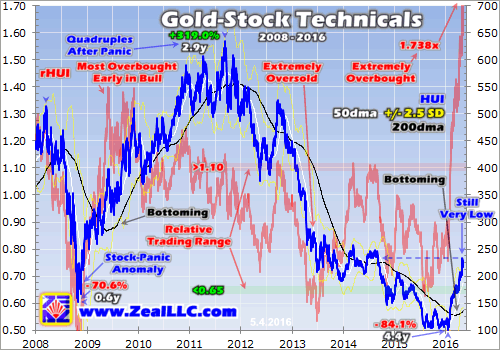
The gold-mining stocks have skyrocketed this year, radically outperforming every other sector. Smart contrarians who bought them low late last year and in January have seen their capital doubled, tripled, and even quadrupled! But such blistering gains raise the ominous specter of crippling overboughtness, conditions preceding major toppings. Have gold stocks come too far too fast to continue their epic run?
The magnitude of recent months’ gold-stock surge is simply stunning. Between mid-January and the end of April, this sector’s flagship HUI NYSE Arca Gold BUGS Index blasted 131.8% higher in merely 3.3 months! This was largely mirrored by the leading gold-stock ETF, the GDX VanEck Vectors Gold Miners ETF. GDX saw stupendous gains of 107.1% over this same span. Gold stocks have been on fire!
But naturally such fast gains have left this sector severely overbought by nearly every measure. That includes the moving-average convergence-divergence indicator, the distance of gold-stock prices above their 50-day moving averages, these same 50dmas’ gap over gold stocks’ 200dmas, and the lofty heights of gold-stock prices relative to their 200dmas. All these indicators also apply to gold-stock indexes and ETFs.
Any technician could easily make the case that gold stocks are positioned for an imminent collapse in light of their extremely-overbought technicals. In fact, that’s the only rational interpretation for analysts focusing exclusively on this sector’s current situation. But as always in the markets, broader context is absolutely essential. Making trading decisions without considering the bigger picture usually ends poorly.
The vast majority of market wisdom on overboughtness comes from major toppings. Extreme levels of overboughtness are famously seen after major bull markets running for years spark popular euphoria sucking in legions of new traders. If the gold stocks had just enjoyed a multi-year bull run to new record highs, and everyone was super-excited about them, then today’s extremes would be screaming sell signals.
But that’s not the case at all. Today’s extreme overboughtness comes after far-more-extreme anomalous secular lows. There’s no popular euphoria in gold stocks today, and certainly no major highs. Only a few months ago, no one beyond the most-hardened contrarians would even dare consider deploying capital in this left-for-dead sector. The current overboughtness was born out of crazy lows, not lofty heights!
Just like weather, the biggest price changes in the markets rapidly follow the greatest anomalies. The largest temperature shifts ever witnessed in weather data happen right after the most-unseasonable extremes. After near-record cold, the mean-reversion temperature swing back up to normal levels will be big and fast. Those resulting typical seasonal levels will be sustainable despite the extreme ramp bringing them.
Maintaining perspective in the markets is the key to overcoming the tyranny of the present over traders’ psychology, which usually leads to bad losing trades. When 2016’s incredible gold-stock surge is put back into the proper context of the months and years leading up to it, today’s extreme overboughtness has very different implications. Despite this sector rallying very far very fast, it is nowhere near topping.
In my decades of intense market research and speculation, I’ve found one of the best ways to measure how far how fast prices have moved is relative to their own 200-day moving averages. 200dmas aren’t static baselines that are soon rendered obsolete, they gradually evolve with price trends. And they work to thoroughly squelch the sometimes-serious volatility in prices, helping clearly delineate prevailing trends.
Many years ago I developed a simple trading tool called Relativity. It recasts prices as multiples of their own 200dmas, by dividing the former by the latter. When charted over time, these multiples tend to form horizontal trading ranges. They express the critical relationship between prices and their 200dma baselines in perfectly-comparable constant-percentage terms. Relativity actually quantifies “too far too fast”.
This first chart looks at the Relative HUI, or rHUI, in red. That’s just this leading gold-stock index’s close on any given trading day divided by its 200dma then. The actual HUI is superimposed in blue, along with some key technical lines including its 50dma, 200dma, and 2.5-standard-deviation Bollinger Bands. While gold stocks are extremely overbought, the context is the polar opposite from a major topping episode.

On April’s final trading day last Friday, the HUI blasted 7.2% higher to 233.5. That stretched this index to an astounding 1.738x its 200dma, in other words this sector was nearly 74% above that key baseline! Such extremes are exceedingly rare, that happened to be an incredible 13.9-year high in the rHUI. Out of 3612 trading days since 2002, the rHUI only exceeded 1.7x on 13 of them. That’s a third of one percent.
And until last Friday, every single one of these extreme rHUI readings showing extreme overboughtness happened in May and June 2002. And that was indeed a major topping, the climax of the enormous 310.7% initial bull run in the first 18.6 months of gold stocks’ new secular bull. But interestingly even in that example, the HUI merely consolidated sideways from there before surging to major new highs in mid-2003.
But I was actively trading gold stocks way back then, and certainly remember the euphoria as the HUI hit that extreme overboughtness. This small contrarian sector was growing popular among mainstream investors, as the general stock markets were trapped in the final months of a cyclical bear which would slash the broad-market S&P 500 index 49.1% lower over 2.6 years. That was a real gold-stock topping.
Today’s situation is radically different. Back in mid-July 2015, an extreme gold-futures shorting attack crushed gold so the HUI plummeted to a brutal 13.0-year secular low by early August. Then it ground sideways near those extreme lows until mid-January, when support at 105 briefly failed. That stretched the gold-stock sector as measured by the HUI to extremely-anomalous apocalyptic 13.5-year secular lows.
That very week I wrote a comprehensive essay on those extreme gold-stock lows, highlighting that they were truly fundamentally-absurd. The gold stocks were literally trading at prices last seen in July 2002. But back then gold was trading near $305, and had yet to exceed $329 in its young secular bull. And that January 2015 day saw gold trading 3.6x higher near $1087! Those gold-stock levels were supremely irrational.
Considered the other way, gold had fallen to a deep 6.1-year secular low in mid-December on Fed-rate-hike fears that history proves were totally unfounded. The last time gold had hit that very same $1050 level, the HUI was 3.7x higher. The gold-stock prices in mid-January were ludicrous, as the markets seemed to be betting that gold miners could only sell gold for 3/11ths of its prevailing price! It was sheer insanity.
That was one of the greatest pricing anomalies we’ll ever witness in our lifetimes, fueled by truly mind-boggling levels of prevailing fear. And it was that ultra-anomalous downside extreme from which this massive 2016 gold-stock bull was born. This year’s sharp gold-stock surge to today’s near-record levels of overboughtness wasn’t born in euphoria, but utter despair. It’s a righteous mean-reversion price swing.
The dominant reason gold stocks have come so far so fast is their pricing in January was so ridiculous. And today’s stretched technicals screaming warnings of severe overboughtness are the direct result of those downside extremes. If gold stocks hadn’t plunged so far so fast last summer, then languished at such crazy lows until January, their technical situation would look far different today as this chart shows.
The HUI’s 50dma was incredibly low before this latest gold-stock buying erupted, and its 200dma was in an extreme downward trajectory. So any measures of overboughtness based off these key moving averages are bound to show extremes. 200dmas in particular are so slow-moving that new bull markets often show severely-overbought readings in their initial months until their 200dmas finally reverse north.
Provocatively this even happened in the broader stock markets back in 2009 as their mighty new bull was born from the ashes of 2008’s first stock panic in a century. Later in 2009 the entire S&P 500 stretched an extreme 20%+ beyond its 200dma, levels that would normally signal a massive imminent selloff. Yet heeding such sell signals would’ve been a colossal mistake, as the stock market’s new bull would run for years.
When prices start mean reverting higher to rebound out of extreme lows, technical indicators often flash dire warnings of extreme overboughtness. This happens in the initial months of major new bull markets that will power much higher on balance for years. So this particular post-bottoming environment emerging from major secular lows is the exception to the rules of overbought indicators. This is true in gold stocks too.
Before we dig deeper into severe overboughtness early in massive new gold-stock bulls, it is also very important to consider the HUI’s absolute levels today. If gold stocks were now trading near major secular highs, which would naturally generate euphoria, then their overboughtness would indeed have grave bearish implications. But the HUI merely hit a modest 19.9-month high last week, not a 20-year one!
Gold stocks last traded at these levels in late 2014, before a couple bouts of panic selling on extreme gold-futures shorting. All the HUI has done in 2016 is regain its uptrend channel enjoyed in late 2014 and the first half of 2015 before last summer’s anomalous breakdown exacerbated by that extreme gold-futures shorting attack. So in absolute terms, gold stocks remain pretty darned low in the grand scheme!

Back in early 2009 soon after gold stocks had started powering higher again, the HUI stretched up near 1.4x its 200dma multiple times. That’s fairly rare statistically too. Out of those 3612 trading days since 2002, the HUI only spent 154 above 1.4x its 200dma. That works out to 4.3%. I remember hearing the same arguments about gold stocks being dangerously overbought back in 2009 as well, portending a topping.
Yet much like today, by that point they had merely doubled on the way to a quadrupling. I just explained a few weeks ago why today’s gold stock bull is due for another easy double after already doubling by that point. The gold stocks looked very overbought technically in 2009 simply because they were mean reverting out of an anomalous downside extreme of major secular lows, moving averages hadn’t caught up.
Again 200dmas in particular take some time to turn. With calendar months averaging 21 trading days, a 200-day moving average encompasses fully 9.5 months of price action. So until a new bull market out of major secular lows passes the halfway point in this critical moving average, it still mostly reflects the downside price action leading into that secular low. 200dmas can’t keep pace with prices as bulls first ignite.
Thanks to their very gradual nature, it always takes some months for 200dmas to bottom, reverse, and turn north decisively. That lagging reversal period can’t reflect the intense buying common early in new bulls. Bull-market price trajectories generally follow a flattening parabolic path, like a ball being thrown up at a steep angle initially. Gains are fast in the first year or so, but then decelerate as the bull matures.
So somewhat paradoxically, the most-overbought levels in bull markets are usually seen in their first year. That was true of both gold stocks in their last bull, and general stock markets in theirs. Between 2009 and 2011, both HUI and S&P 500 Relativity multiples gradually moderated as those respective bull markets powered higher. By the times each peaked, they weren’t overbought at all on a technical basis!
With the exception of rare popular-mania blow-off tops, bull markets generally don’t die with readings of extreme overboughtness. Instead they gradually run out of steam as the supply of new buyers willing and able to commit more capital dwindles. So outside of that extreme mania situation, overboughtness has never been a good indicator of bull markets ready to give up their ghosts. It is actually an early-bull thing.
Still, today’s HUI way up at 1.74x its 200dma is far more extreme than the early-2009 overboughtness of 1.40x. But that’s misleading, a distortion from the technical lead-ins to both new gold-stock bulls. Back in late 2008, this sector’s secular-low extremes were very short-lived lasting mere weeks. That’s a sharp contrast from late 2015’s, which ran for 5.5 months. That long span of lows really dragged down the HUI’s 200dma.
Note in this chart how high the 200dma bottom was in early 2009 following late 2008’s fleeting extreme low compared to early 2016’s 200dma bottom after late 2015’s lingering lows. Since the HUI’s 200dma was dragged to anomalously-low extremes even by secular-bottoming standards as this year dawned, naturally the typical sharp early-bull gold-stock rally is going to stretch much farther above such lows.
And rather amazingly, 2016’s young new gold-stock bull was actually considerably less extreme than the one emerging from 2008’s stock panic! Back in late 2008 it only took the HUI 45 trading days, or 9 weeks, to double out of its extreme fear-drenched secular low. But in early 2016 the HUI took 57 trading days, more than 11 weeks, for that same initial double! Gold stocks advanced farther faster last time around.
So all gold-stock investors and speculators need to realize that the perceived extreme overboughtness of this sector today is misleading. Gold stocks have indeed come very far very fast in recent months, but they are nowhere near as overbought as the classic technical indicators suggest. Those very indicators remain heavily skewed by the abnormally-long period of gold-stock secular lows persisting late last year.
There is almost zero chance today’s extreme overboughtness heralds the end of this young gold-stock bull as some fear. In fact, just the opposite is true. The fact that gold stocks soared so far so fast in early 2016 to achieve severe overboughtness shows typical early-bull behavior. It suggests this new gold-stock buying is strong enough to persist for years, with capital inflows continuing to drive gold stocks higher.
That being said, overboughtness remains an important short-term indicator. Though May happens to be gold stocks’ strongest month of the year seasonally in bull markets, with an average HUI gain of 6.9% between 2001 and 2012, summer is coming. June and July are the weakest time of year for the entire precious-metals realm, the dreaded summer doldrums. Odds are gold stocks will drift lower as usual then.
So for investors and speculators worried about deploying more capital after such a blistering gold-stock rally, we may very well see better entry points towards late July if normal seasonals hold. While there is certainly no guarantee that normal market conditions will exist this summer with all the craziness in the markets this year, that’s what probabilities favor. A few-month consolidation would be very healthy for this bull.
Despite their extreme overboughtness and weaker seasonals ahead, the gold stocks remain radically undervalued relative to the prevailing gold price. That’s what drives their profits and thus ultimately their stock prices. At $1250 gold, the HUI would have to soar near 433 to merely mean revert to its post-panic average level relative to gold without overshooting. That’s more than a double even from this week’s levels!
While the HUI was indeed up a scary-sounding 110.0% year-to-date at last Friday’s peak, it had still only rallied 42.3% since the dawn of 2015 and a minor 18.1% since early 2014. A mere 40%ish sector rally unfolding across 16 months or 20%ish over 28 months wouldn’t even warrant a second glance by any technicians. Considered in broader context, today’s gold-stock levels are practically yawn-inducing!
That’s even more evident zooming out from this many-months perspective to a secular many-years one. This final chart looks at the HUI and rHUI since 2008, encompassing the last major gold-stock bull. This sector more than quadrupled emerging from those anomalous 2008-stock-panic lows, soaring 319.0% higher in 2.9 years. And provocatively gold stocks were the most overbought in that bull’s early months!
The bottom line is gold stocks are indeed absolutely overbought after skyrocketing in 2016. But this isn’t some dire bearish topping signal as feared. Technical overboughtness is actually common in young bull markets, since the moving averages haven’t yet had time to fully reverse and reflect the new trend. Severe overboughtness following major secular lows is actually a confirmation a new bull should run for years.
Gold stocks only look extremely overbought today because their recent major secular lows persisted for far longer than normal. That dragged their moving averages far lower than normal, greatly exaggerating recent reads on key technical indicators. But those will soon normalize. Gold stocks remain radically undervalued relative to prevailing gold prices today, so their mean reversions higher have a long ways to go.



 Follow us on Twitter
Follow us on Twitter Become our facebook fan
Become our facebook fan









Comments are closed.